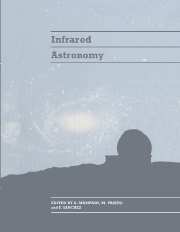Book contents
- Frontmatter
- Contents
- List of Participants
- Preface
- 1 Star Formation
- 2 Last Stages of Stellar Evolution
- 3 The Milky Way Galaxy and the Galactic Centre
- 4 Galaxies in the Infrared
- 5 Cosmology
- 6 G25.2+0.2, a New Ring Nebula Around a Luminous Blue Star: Case Study for the Importance of IR Observations
- 7 Two Colloquia on Cosmic Dust
- 8 Infrared Instrumentation
- 9 Infrared Astronomy with Satellites
3 - The Milky Way Galaxy and the Galactic Centre
Published online by Cambridge University Press: 23 December 2009
- Frontmatter
- Contents
- List of Participants
- Preface
- 1 Star Formation
- 2 Last Stages of Stellar Evolution
- 3 The Milky Way Galaxy and the Galactic Centre
- 4 Galaxies in the Infrared
- 5 Cosmology
- 6 G25.2+0.2, a New Ring Nebula Around a Luminous Blue Star: Case Study for the Importance of IR Observations
- 7 Two Colloquia on Cosmic Dust
- 8 Infrared Instrumentation
- 9 Infrared Astronomy with Satellites
Summary
INTRODUCTION
It is widely though erroneously believed that one can see the Milky Way Galaxy. In fact, one's image of the Milky Way depends more on how one looks at it than on what is available to be seen. For reasons which are related to population biology more than to astrophysics, our eyes are optimised to detect the peak energy output from thermal sources with a surface temperature near 6000K. Thus, unless such an object is typical of the entire contents of the Galaxy, there is no reason why we should be able to see by eye a representative part of whatever may be out there. If we had X-ray or UV sensitive eyes we would ‘see’ only hotter objects, if infrared or microwave eyes only cooler objects.
No single section of the electro-magnetic spectrum provides the ‘best’ view of the Galaxy. Rather, all views are complementary. However, some views are certainly more representative than are others. The most fundamental must be a view of the entire contents of the Galaxy. Such a view would require access to a universal property of matter, which was independent of the state of that matter. This is provided by gravity, since all matter, by definition, has mass. Mass generates the gravitational potential, which in turns defines the size and the shape of the Galaxy. While the most reliable and comprehensive, such a view is also the hardest to derive. Nonetheless, we will repeatedly return to the gravitational picture of the Galaxy in these lectures.
- Type
- Chapter
- Information
- Infrared Astronomy , pp. 123 - 172Publisher: Cambridge University PressPrint publication year: 1994

